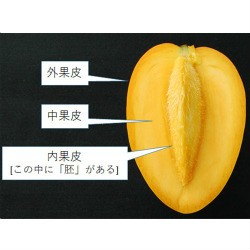Morphological Traits: Fruits and seeds
What parts of mango do we eat?

The mango is a fruit called a "kernel". A "kernel" is a general term for a fruit that has a structure in which the skin and pulp surround a hard nucleus (shell) and the seed is inside the nucleus. Peaches, cherries, almonds, coffee, etc. are also nuclear fruits. Usually, the outer “pericarp" has a beautiful color, and the "mesocarp" is thick and fleshy, storing nutrients such as sugar and fat, giving it a delicious aroma and taste, and attracting animals to disperse the seeds.
Morphologically, the mango fruit is composed of three parts (see photo), namely,
(1) outer pericarp (morphologically called "exocarp")
(2) pulp, which we eat (morphologically called "mesocarp")
(3) the part we commonly call seed (morphologically, the “endocarp” and embryo).